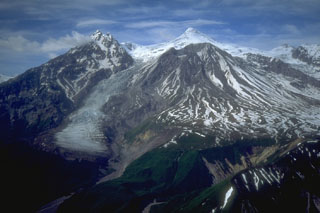Report on Spurr (United States) — November 1992
Bulletin of the Global Volcanism Network, vol. 17, no. 11 (November 1992)
Managing Editor: Lindsay McClelland.
Spurr (United States) Continued seismicity and gas emission
Please cite this report as:
Global Volcanism Program, 1992. Report on Spurr (United States) (McClelland, L., ed.). Bulletin of the Global Volcanism Network, 17:11. Smithsonian Institution. https://doi.org/10.5479/si.GVP.BGVN199211-313040
Spurr
United States
61.299°N, 152.251°W; summit elev. 3374 m
All times are local (unless otherwise noted)
Occasional seismicity has continued at Mt. Spurr since the eruptive episode of 16-17 September. Earthquakes were concentrated in the vicinity of Crater Peak, the S-flank vent that has been the source of the 1992 activity. Focal depths from early November through early December ranged from above sea level to 44 km. In addition to the few locatable events per day, many small earthquakes that could not be precisely located were detected by one or more stations in the area. No strong swarms have occurred since 9-10 November, when a series of shallow events raised alert levels but did not culminate in an eruption. A number of episodes of low-amplitude tremor were recorded at some stations near Crater Peak 26-27 November.
Gas emission continued from Crater Peak, feeding a plume that sometimes rises to 3,300 m. Even though the plume's SO2 content has been below COSPEC detection limits since mid-October, sulfur gases could still be smelled. CO2 content remained above background at near 1,000 metric tons/day (table 1).
Table 1. Emission rates, in metric tons/day, of SO2 and CO2 at Spurr, 8 June 1991-15 November 1992; other events are noted for context. SO2 values, measured by COSPEC, are averages of 2-5 daily aerial observations, taken looking up through the plume. Measured SO2 flux decreased during tremor episodes 3-5 October. CO2 data are from direct plume samples analyzed with a Miran infrared spectrometer. Courtesy of AVO.
| Date | SO2 | CO2 |
| 08 Jun 1991 | 21 | -- |
| 22 Jul 1991 | Very low | Very low |
| 21 Aug 1991 | 0 | -- |
| 29 Aug 1991 | 0 | -- |
| 03 Sep 1991 | 85 | -- |
| 22 Nov 1991 | 0 | -- |
| 14 May 1992 | 88 | -- |
| 27 Jun 1992 | Eruption | |
| 29 Jun 1992 | 5 | -- |
| 18 Aug 1992 | Eruption | |
| 10 Sep 1992 | 0 | -- |
| 16-17 Sep 1992 | Eruption | |
| 21 Sep 1992 | 23 | -- |
| 23 Sep 1992 | 24 | -- |
| 24 Sep 1992 | 79 | -- |
| 25 Sep 1992 | 300 | 11,000 |
| 28 Sep 1992 | 194 | 12,000 |
| 29 Sep 1992 | 749 | 8,700 |
| 02 Oct 1992 | 452 | -- |
| 03 Oct 1992 | 220 | 4,800 |
| 04 Oct 1992 | 212 | 3,500 |
| 05 Oct 1992 | 356 | 2,900 |
| 10 Oct 1992 | 243 | -- |
| 14 Oct 1992 | 47 | 2,400 |
| 15 Oct 1992 | 64 | -- |
| 16 Oct 1992 | Low | Low |
| 19 Oct 1992 | Background | Background |
| 23 Oct 1992 | 24 | 2,100 |
| 29 Oct 1992 | Background | Background |
| 09 Nov 1992 | Seismic swarm | |
| 10 Nov 1992 | Background | Background |
| 11 Nov 1992 | Background | Background |
| 12 Nov 1992 | Background | 1,100 |
| 13 Nov 1992 | Background | 1,000 |
| 15 Nov 1992 | Background | 1,000 |
Geological Summary. Mount Spurr is the closest volcano to Anchorage, Alaska (130 km W) and just NE of Chakachamna Lake. The summit is a large lava dome at the center of a roughly 5-km-wide amphitheater open to the south formed by a late-Pleistocene or early Holocene debris avalanche and associated pyroclastic flows that destroyed an older edifice. The debris avalanche traveled more than 25 km SE, and the resulting deposit contains blocks as large as 100 m in diameter. Several ice-carved post-collapse cones or lava domes are present. The youngest vent, Crater Peak, formed at the southern end of the amphitheater and has been the source of about 40 identified Holocene tephra layers. Eruptions from Crater Peak in 1953 and 1992 deposited ash in Anchorage.
Information Contacts: AVO.

